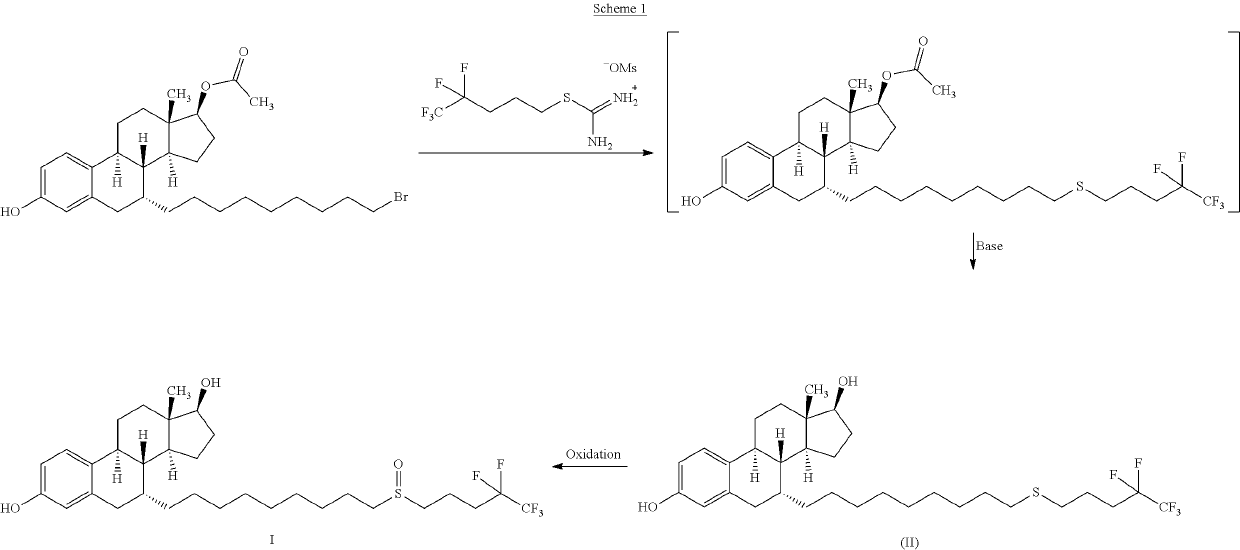Process for the preparation of fulvestrant
a technology of fulvestrant and fulvestrant, which is applied in the field of process for the preparation of fulvestrant, can solve the problems of significant quantities of some by-products, lowering the overall yield of the process, and not being suitable for commercial purposes
- Summary
- Abstract
- Description
- Claims
- Application Information
AI Technical Summary
Benefits of technology
Problems solved by technology
Method used
Image
Examples
example 1
for Obtaining Waste Fulvestrant
[0039]The fractions of the chromatographic column containing Fulvestrant with the diastereoisomeric ratio not complying with the specifications and enriched with sulfone and the mother liquors of final crystallization are combined. The solvent is distilled under vacuum to a residue. The residue is added with toluene and the mixture is heated up to 70° C. It is cooled to 20° C. and the crystallization of the product is obtained. The product is filtered on Buchner and washed with toluene. The product is dried in an oven at 50° C. under vacuum for 15 h.
example 2
[0040]Waste Fulvestrant (5 g, 8.24 mmol) is loaded into a 3-necked flask equipped with a mechanical stirrer, thermometer and condenser. Chloroform (25 ml) is charged under nitrogen and there is complete dissolution. Sodium metabisulfite (1.67 g, 8.8 mmol) and iodine (0.20 g, 0.8 mmol) are added to the solution. The reaction mixture is heated under reflux and monitored over time. After 18 h the reaction is complete (conversion>99%). The reaction mixture is cooled to 25±5° C. and demineralized water (15 ml) is added. The phases are separated and the organic phase is washed once with a saturated sodium chloride solution (5 ml). The phases are separated and the organic phase is concentrated under vacuum to a residue. About 4.5 g of product are obtained as thick oil.
example 3
[0041]Waste Fulvestrant (20 g, 32.97 mmol) is loaded into a 3-necked flask equipped with a mechanical stirrer, thermometer and condenser. THF (100 ml) is charged under nitrogen and there is complete dissolution. Sodium metabisulfite (6.9 g, 36.26 mmol) and iodine (0.83 g, 3.3 mmol) are added to the solution. The reaction mixture is heated under reflux and monitored over time. After 8 h the reaction is complete (conversion>99%). The reaction mixture is cooled to 25±5° C. and demineralized water (60 ml) and toluene (100 ml) are added. The phases are separated and the organic phase is washed once with a saturated sodium chloride solution (5 ml). The phases are separated and the organic phase is dehydrated with magnesium sulphate and concentrated under vacuum to a residue. About 20.3 g of product are obtained as thick oil.
PUM
| Property | Measurement | Unit |
|---|---|---|
| temperature | aaaaa | aaaaa |
| aqueous | aaaaa | aaaaa |
| concentration | aaaaa | aaaaa |
Abstract
Description
Claims
Application Information
 Login to View More
Login to View More - R&D
- Intellectual Property
- Life Sciences
- Materials
- Tech Scout
- Unparalleled Data Quality
- Higher Quality Content
- 60% Fewer Hallucinations
Browse by: Latest US Patents, China's latest patents, Technical Efficacy Thesaurus, Application Domain, Technology Topic, Popular Technical Reports.
© 2025 PatSnap. All rights reserved.Legal|Privacy policy|Modern Slavery Act Transparency Statement|Sitemap|About US| Contact US: help@patsnap.com



